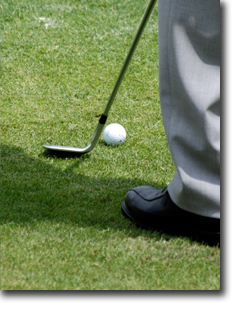What is a pitch shot?
A pitch shot generally flies higher and lands on the ground softer with less roll out of the shot. The pitch shot is required when there is some type of obstacle in the way to the hole such as: bunkers, rough terrain, trees, bushes or rocks. The pitch shot is hit with the more lofted clubs such as: pitching wedges, gap wedges and lob wedges.
Fundamentals needed to pitch well:
- The ball should be positioned more centered to slightly forward in the stance.
-
Your weight should be more on the front foot in your stance. This is the foot closer to the target. Some pitch shots may not require all the weight on the front foot, but in general it’s best to have more weight forward.
- The shaft lean is more neutral with the hands more even with the ball. With the ball being more centered to slightly forward, there is naturally less leaning of the shaft towards the target at address and through the contact.
- Learn to use the bounce of your wedge to help regulate how deep your club will dig into the turf. The bounce is the back bottom flange of the club. The degree of bounce is measured by how much lower the back bottom of the club is below the leading edge of the club. For example with a very high lofted sand wedge, if you set the club square to the target with the hands directly over the ball, you will notice that the leading edge of the golf club is not flush to the ground. The leading edge is off the ground because the club resting on the bounce. If you lean the shaft towards the target you can get the leading edge of the club to get even to the ground but you also take loft off of the club. Learning to use the club’s bounce properly will help you regulate how deep your club will dig into the turf. If your hands are too far forward and there is too much lean of the shaft, you may stick the club into the turf because you have reduced the clubs bounce, which makes the club dig too deep into the turf.
- Grip down on the club to shorten the club and make the contact more consistent. You will need to make more swing when you pitch than when you chip. Remember that you have a club with a higher degree of loft. In order to get the ball higher into the air you must swing long enough to generate enough speed to create the amount of spin necessary to get the ball up and over an obstacle.
- Keep your chin up and keep your head still.
- The bottom of your swing should be slightly before the ball or directly at the ball. Being that this is the case, you do not want to drag the leading edge into the ground before the ball.
- Keep the back shoulder taller throughout the shot. During the set up, in the backswing and very important in the downswing make sure that your back shoulder does not drop. If you drop your back shoulder during the downswing you will chunk the shot and dig the club into the ground. Keeping your back shoulder up throughout the downswing will allow the club to bottom out in a consistent spot. When you trust that your club will bottom out at the correct spot you will swing the club through the shot more freely resulting in higher and softer lofted shots.
Pitch when chipping or putting is not an option.
Pitching requires a longer swing. There are more things that can potentially go wrong. Always try to choose the highest percentage shots first then fall back to the riskier shots as a last resort. Practice accelerating through the shots and gaining more trust and confidence. These shots require rhythm and fluidity. If you have not practiced them enough and you have a high level of anxiety toward these shots, Stay away from them!! Chip it sideways and avoid trouble if it will help you avoid chunking it short or sculling a shot across a green into more trouble. |




